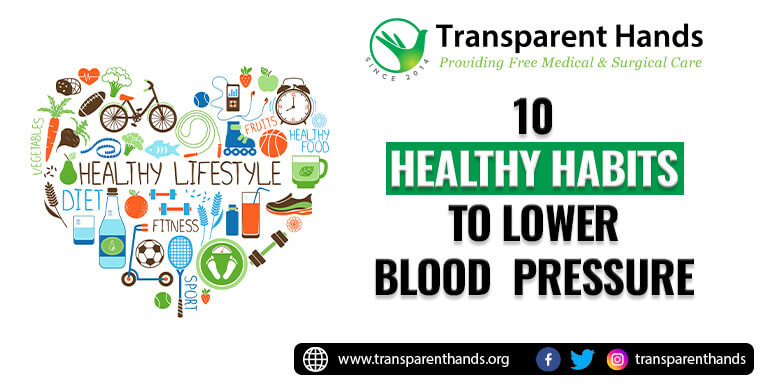10 Healthy Habits to Lower Blood Pressure

Blood pressure is the force that flowing blood exerts on the walls of blood vessels, particularly arteries, as it passes through them. It is expressed as two measurements: systolic pressure over diastolic pressure. The higher number is the systolic pressure, which corresponds to the pressure in the arteries when the heart contracts and pumps blood out. The diastolic pressure is the lower number and represents the pressure in the arteries when the heart is at rest between beats. It is simple to check at home using an electronic or automated device.
Blood Pressure Range
Blood pressure is important because it indicates how well the cardiovascular system is working. It is influenced by a variety of factors, including the force and efficiency of the heart’s pumping action, blood volume, and the resistance of the arteries. The normal blood pressure range is typically 120/80 mmHg, but it can vary depending on individual factors.
Abnormal blood pressure ranges can indicate certain health conditions. Hypertension, also known as high blood pressure, occurs when the force of blood against the artery walls is consistently too great. Hypotension, or low blood pressure, occurs when the blood force is insufficient. Both conditions can affect your health as a whole and may require medical help or changes to your lifestyle to be treated well.
Blood Pressure Chart
It is important to remember that these are general guidelines and that individual circumstances may differ. It is always best to seek personalized advice and recommendations on managing and lowering blood pressure from a healthcare professional.
Symptoms of High Blood Pressure
High blood pressure or hypertension is often called the “silent killer” because it does not cause any obvious symptoms. But some people may have certain symptoms that could mean they have hypertension. Persistent headaches, dizziness, blurred vision, chest pain, shortness of breath, fatigue, an irregular heartbeat, or blood in the urine are some of the symptoms. It is critical to monitor your blood pressure levels on a regular basis and to seek medical attention to lower your blood pressure.
How to Lower Blood Pressure?
Healthy Diet
It is advisable to limit your consumption of processed and packaged foods high in sodium. You must opt for fresh ingredients and use herbs and spices to add flavor instead. Consuming potassium-rich foods such as bananas, spinach, avocados, and sweet potatoes can help counteract the negative effects of sodium. You can also consider the Dietary Approaches to Stop Hypertension (DASH) eating plan, which emphasizes fruits, vegetables, whole grains, lean proteins, and low-fat dairy. Taking fiber can help reduce hypertension and enhance cardiovascular health.
Regular Exercise
You must aim to do at least 150 minutes per week of aerobic exercise of moderate intensity or 75 minutes per week of vigorous activity. Walking, cycling, swimming, or jogging are also excellent options. You can also include strength training at least twice per week to improve cardiovascular fitness and lower blood pressure.
Benefits of Exercise for Better Health
Lose Excess Weight
Those who are overweight or obese can significantly reduce their blood pressure by losing as little as 5-10% of their body weight. Restrict your consumption of foods and beverages high in calories and sugar. Focus on consuming a well-balanced diet with proper portion sizes.
Manage Stress
You may also engage in stress-relieving activities such as deep breathing exercises, meditation, and yoga. Spend time doing something you enjoy, whether it is hanging out with friends or family or pursuing a passion. These are the best ways to reduce high blood pressure.
Quit Smoking
Smoking can cause high blood pressure and blood vessel damage. Quitting smoking is critical for overall cardiovascular health. Avoid secondhand smoke because it can also contribute to hypertension. Consult a healthcare professional for help, support groups, or medications to help you quit smoking.
Reduce Sodium Intake
High sodium levels can contribute to higher blood pressure. Limit your consumption of processed foods, fast food, and added salt. Aim to consume no more than 2,300 milligrams (mg) of sodium per day.
Limit Caffeine Intake
While the effects of caffeine on blood pressure vary from person to person, limiting your caffeine intake may be beneficial, especially if you are sensitive to its effects.
Increase Potassium Intake
Potassium helps regulate blood pressure. Include potassium-rich foods in your diet such as bananas, oranges, tomatoes, spinach, avocados, and sweet potatoes.
Monitor Blood Pressure
You must also schedule routine visits with your healthcare provider to monitor your blood pressure and make any necessary adjustments to your treatment plan if required.
Limit Alcohol Consumption
Excessive alcohol consumption can raise blood pressure. If you choose to drink, do so in moderation—up to one drink per day for women and up to two drinks per day for men.
Conclusion
Remember to seek personalized advice and recommendations from a healthcare professional based on your specific health condition. They can advise you on lifestyle changes and medications, as needed, and track your progress to help you effectively reduce your high blood pressure.










Leave a Reply